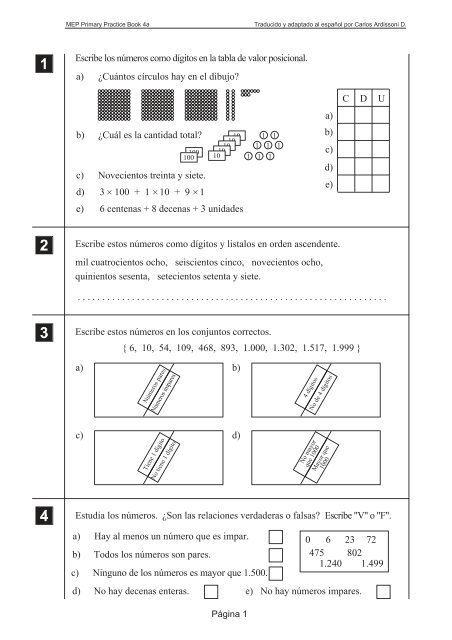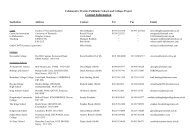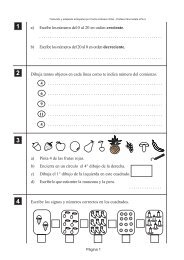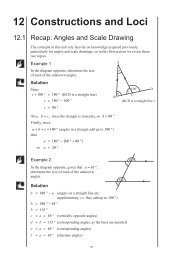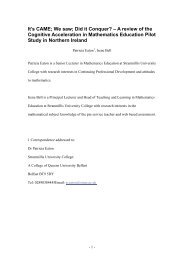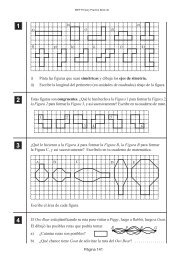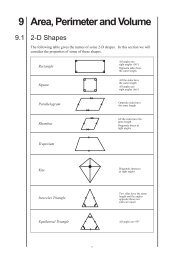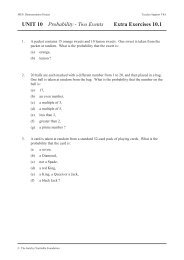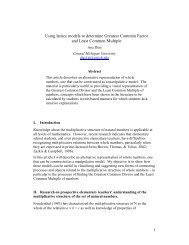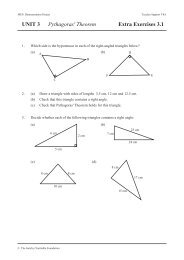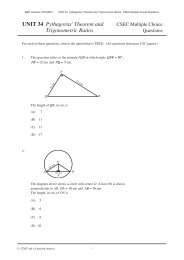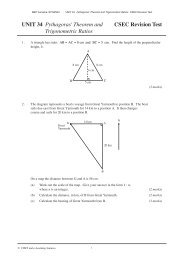Escribe los números como dígitos en la tabla de valor posicional ...
Escribe los números como dígitos en la tabla de valor posicional ...
Escribe los números como dígitos en la tabla de valor posicional ...
Create successful ePaper yourself
Turn your PDF publications into a flip-book with our unique Google optimized e-Paper software.
11<br />
11<br />
22<br />
22<br />
33<br />
33<br />
44<br />
44<br />
MEP Primary Practice Book 4a Traducido y adaptado al español por Car<strong>los</strong> Ardissoni D.<br />
<strong>Escribe</strong> <strong>los</strong> <strong>números</strong> <strong>como</strong> <strong>dígitos</strong> <strong>en</strong> <strong>la</strong> tab<strong>la</strong> <strong>de</strong> <strong>valor</strong> <strong>posicional</strong>.<br />
a) ¿Cuántos círcu<strong>los</strong> hay <strong>en</strong> el dibujo?<br />
b) ¿Cuál es <strong>la</strong> cantidad total?<br />
<strong>Escribe</strong> estos <strong>números</strong> <strong>como</strong> <strong>dígitos</strong> y lista<strong>los</strong> <strong>en</strong> ord<strong>en</strong> asc<strong>en</strong>d<strong>en</strong>te.<br />
mil cuatroci<strong>en</strong>tos ocho, seisci<strong>en</strong>tos cinco, noveci<strong>en</strong>tos ocho,<br />
quini<strong>en</strong>tos ses<strong>en</strong>ta, seteci<strong>en</strong>tos set<strong>en</strong>ta y siete.<br />
. . . . . . . . . . . . . . . . . . . . . . . . . . . . . . . . . . . . . . . . . . . . . . . . . . . . . . . . . . . . . . .<br />
<strong>Escribe</strong> estos <strong>números</strong> <strong>en</strong> <strong>los</strong> conjuntos correctos.<br />
{ 6, 10, 54, 109, 468, 893, 1.000, 1.302, 1.517, 1.999 }<br />
Estudia <strong>los</strong> <strong>números</strong>. ¿Son <strong>la</strong>s re<strong>la</strong>ciones verda<strong>de</strong>ras o falsas? <strong>Escribe</strong> "V" o "F".<br />
a) Hay al m<strong>en</strong>os un número que es impar.<br />
b) Todos <strong>los</strong> <strong>números</strong> son pares.<br />
10 1 1<br />
10<br />
10 1 1 1<br />
100 10<br />
100 10 1 1 1<br />
c) Noveci<strong>en</strong>tos treinta y siete.<br />
d) 3 × 100 + 1 × 10 + 9 × 1<br />
e) 6 c<strong>en</strong>t<strong>en</strong>as + 8 <strong>de</strong>c<strong>en</strong>as + 3 unida<strong>de</strong>s<br />
a) b)<br />
Números pares<br />
Números impares<br />
c) d)<br />
Ti<strong>en</strong>e 1 dígito<br />
No ti<strong>en</strong>e 1 dígito<br />
c) Ninguno <strong>de</strong> <strong>los</strong> <strong>números</strong> es mayor que 1.500.<br />
d) No hay <strong>de</strong>c<strong>en</strong>as <strong>en</strong>teras. e) No hay <strong>números</strong> impares.<br />
Página 1<br />
No mayor<br />
que 1000<br />
Mayor que<br />
1000<br />
a)<br />
b)<br />
c)<br />
d)<br />
e)<br />
4 <strong>dígitos</strong><br />
No <strong>de</strong> 4 <strong>dígitos</strong><br />
C D U<br />
0 6 23 72<br />
475 802<br />
1.240 1.499
11<br />
11<br />
22<br />
22<br />
33<br />
33<br />
44<br />
44<br />
55<br />
55<br />
MEP Primary Practice Book 4a Traducido y adaptado al español por Car<strong>los</strong> Ardissoni D.<br />
Encu<strong>en</strong>tra <strong>los</strong> <strong>números</strong> que faltan, luego lísta<strong>los</strong> <strong>en</strong> ord<strong>en</strong> <strong>de</strong>sc<strong>en</strong>d<strong>en</strong>te.<br />
8 × 100 + 5 × 10 = 3 × 100 + 7 × 1 =<br />
8 × 100 + 5 × 1 = 3 × 100 + 7 × 10 =<br />
1 × 1.000 + 6 × 10 = 1 × 1.000 + 8 × 100 =<br />
1 × 1.000 + 6 × 1 = 1 × 100 + 8 × 10 =<br />
. . . . . . . . . . . . . . . . . . . . . . . . . . . . . . . . . . . . . . . . . . . . . . . . . . . . . . . . . . . . . . . .<br />
Encu<strong>en</strong>tra <strong>los</strong> <strong>números</strong> que faltan, luego lísta<strong>los</strong> <strong>en</strong> ord<strong>en</strong> asc<strong>en</strong>d<strong>en</strong>te.<br />
600 + 30 = 1.000 + 500 + 4 =<br />
300 + 60 = 1.000 + 40 + 5 =<br />
600 + 3 = 1.000 + 900 + 1 =<br />
300 + 6 = 1.000 + 90 + 1 =<br />
. . . . . . . . . . . . . . . . . . . . . . . . . . . . . . . . . . . . . . . . . . . . . . . . . . . . . . . . . . . . . . . .<br />
<strong>Escribe</strong> <strong>números</strong> <strong>en</strong>teros hasta 1000 cuya suma <strong>de</strong> sus <strong>dígitos</strong> sea 3.<br />
. . . . . . . . . . . . . . . . . . . . . . . . . . . . . . . . . . . . . . . . . . . . . . . . . . . . . . . . . . . . . . . .<br />
<strong>Escribe</strong> <strong>los</strong> Numerales Romanos <strong>como</strong> Numerales Arábicos<br />
a) CV = b) CXXXIX =<br />
c) CXLVIII = d) DCLX =<br />
e) CMIX = f) MCMXCVIII =<br />
<strong>Escribe</strong> <strong>los</strong> <strong>números</strong> que t<strong>en</strong>gan:<br />
a) un dígito par <strong>en</strong> el lugar <strong>de</strong> <strong>la</strong> c<strong>en</strong>t<strong>en</strong>a y 500 as their nearest t<strong>en</strong>.<br />
. . . . . . . . . . . . . . . . . . . . . . . . . . . . . . . . . . . . . . . . . . . . . . . . . . . . . . . . . . .<br />
b) an odd digit as their hundreds digit and 500 as their nearest t<strong>en</strong>.<br />
. . . . . . . . . . . . . . . . . . . . . . . . . . . . . . . . . . . . . . . . . . . . . . . . . . . . . . . . . . .<br />
c) the smallest ev<strong>en</strong> digit as their t<strong>en</strong>s digit and 1010 as their nearest t<strong>en</strong>.<br />
. . . . . . . . . . . . . . . . . . . . . . . . . . . . . . . . . . . . . . . . . . . . . . . . . . . . . . . . . . .<br />
Página 2
11<br />
11<br />
22<br />
22<br />
33<br />
33<br />
44<br />
44<br />
MEP Primary Practice Book 4a Traducido y adaptado al español por Car<strong>los</strong> Ardissoni D.<br />
La reg<strong>la</strong> para <strong>los</strong> próximos términos <strong>en</strong> <strong>la</strong> secu<strong>en</strong>cia es: 3 veces el témino previo más 2.<br />
a) <strong>Escribe</strong> <strong>los</strong> primeros seis términos <strong>de</strong> <strong>la</strong> secu<strong>en</strong>cia si el primer término es 2.<br />
. . . . . . . . . . . . . . . . . . . . . . . . . . . . . . . . . . . . . . . . . . . . . . . . . . . . . . . . . . . .<br />
b) <strong>Escribe</strong> <strong>los</strong> primeros seis términos <strong>de</strong> <strong>la</strong> secu<strong>en</strong>cia si el primer término es 3.<br />
. . . . . . . . . . . . . . . . . . . . . . . . . . . . . . . . . . . . . . . . . . . . . . . . . . . . . . . . . . . .<br />
Completa <strong>la</strong>s tab<strong>la</strong>s.<br />
a) b)<br />
Cercano a <strong>la</strong> <strong>de</strong>c<strong>en</strong>a<br />
Número<br />
m<strong>en</strong>or mayor<br />
3<br />
27<br />
86<br />
105<br />
341<br />
450<br />
500<br />
996<br />
Marca <strong>los</strong> <strong>números</strong> con un punto y una letra <strong>en</strong> <strong>la</strong> recta numérica.<br />
a = 205<br />
g = 490<br />
b = 640<br />
h = 250<br />
<strong>Escribe</strong> <strong>los</strong> <strong>números</strong><br />
<strong>en</strong> <strong>la</strong> tab<strong>la</strong>.<br />
Aproximado a<br />
<strong>la</strong> <strong>de</strong>c<strong>en</strong>a<br />
c = 432<br />
i = 1.075<br />
400 450<br />
Página 3<br />
Cercano a <strong>la</strong> c<strong>en</strong>t<strong>en</strong>a<br />
Número<br />
Aproximado a<br />
m<strong>en</strong>or mayor <strong>la</strong> c<strong>en</strong>t<strong>en</strong>a<br />
200 300<br />
600 1.000<br />
5, 100, 909,<br />
0, 217, 1.000,<br />
13, 352, 1.215,<br />
60, 834, 1.605,<br />
78, 900, 1.780<br />
d = 278<br />
j = 500<br />
3<br />
27<br />
86<br />
105<br />
341<br />
450<br />
500<br />
996<br />
e = 486<br />
k = 1.200<br />
f<br />
l<br />
= 1.005<br />
= 455<br />
El número es par impar<br />
divisible<br />
por 5<br />
no es divisible<br />
por 5
11<br />
11<br />
22<br />
22<br />
33<br />
33<br />
44<br />
44<br />
MEP Primary Practice Book 4a Traducido y adaptado al español por Car<strong>los</strong> Ardissoni D.<br />
Continúa el patrón. Pinta <strong>la</strong> parte correcta <strong>de</strong> <strong>los</strong> círcu<strong>los</strong> <strong>en</strong> el gráfico <strong>de</strong> flujo.<br />
1 2 3 4 5 6 7 8 9 10<br />
Inicio<br />
Continúa <strong>la</strong> secu<strong>en</strong>cia usando Numerales Romanos.<br />
a) XLVII, LXVII, LXXXVII, . . . . . . . . . . . . . . . . . . . . . . . . . . . . . . . . . . . .<br />
b) CMI, DCCCI, DCCI, . . . . . . . . . . . . . . . . . . . . . . . . . . . . . . . . . . . . . . . .<br />
Aproxima <strong>los</strong> <strong>números</strong>.<br />
Completa <strong>la</strong> tab<strong>la</strong>.<br />
Número<br />
4<br />
36<br />
50<br />
95<br />
172<br />
600<br />
999<br />
1.050<br />
1.846<br />
Aproxímalo a <strong>la</strong>:<br />
<strong>de</strong>c<strong>en</strong>a c<strong>en</strong>t<strong>en</strong>a unidad <strong>de</strong> mil<br />
<strong>Escribe</strong> el significado <strong>de</strong> cada conjunto <strong>en</strong> <strong>la</strong> tab<strong>la</strong>. <strong>Escribe</strong> otros 3 <strong>números</strong> <strong>en</strong> c/conjunto.<br />
C<br />
420 368<br />
716<br />
Ingresa<br />
el número<br />
SI<br />
A B<br />
6 78 1.098<br />
D 235 851 999 3 57 1.003<br />
Diví<strong>de</strong>lo<br />
por 3<br />
¿Es el<br />
residuo 1?<br />
NO<br />
A:<br />
B:<br />
C:<br />
D:<br />
Página 4<br />
¿Hay<br />
residuo?<br />
SI<br />
NO<br />
Fin
11<br />
22<br />
22<br />
33<br />
33<br />
44<br />
44<br />
MEP Primary Practice Book 4a Traducido y adaptado al español por Car<strong>los</strong> Ardissoni D.<br />
<strong>Escribe</strong> estos <strong>números</strong> <strong>en</strong> pa<strong>la</strong>bras.<br />
a) 3.210 . . . . . . . . . . . . . . . . . . . . . . . . . . . . . . . . . . . . . . . . . . . . . . . . . . .<br />
b) 7.004 . . . . . . . . . . . . . . . . . . . . . . . . . . . . . . . . . . . . . . . . . . . . . . . . . . .<br />
c) 2.300 . . . . . . . . . . . . . . . . . . . . . . . . . . . . . . . . . . . . . . . . . . . . . . . . . . .<br />
d) 995 . . . . . . . . . . . . . . . . . . . . . . . . . . . . . . . . . . . . . . . . . . . . . . . . . . .<br />
e) 1.068 . . . . . . . . . . . . . . . . . . . . . . . . . . . . . . . . . . . . . . . . . . . . . . . . . . .<br />
¿Cuántos <strong>números</strong> <strong>de</strong> 3 <strong>dígitos</strong> pue<strong>de</strong>s formar <strong>de</strong> estos tres <strong>dígitos</strong>? 5 6 1<br />
a) Completa <strong>los</strong> tres diagramas.<br />
b) Lista <strong>los</strong> <strong>números</strong> . . . . . . . . . . . . . . . . . . . . . . . . . . . . . . . . . . . . . . . . . . . . .<br />
. . . . . . . . . . . . . . . . . . . . . . . . . . . . . . . . . . . . . . . . . . . . . . . . . . . . . . . . . . . .<br />
. . . . . . . . . . . . . . . . . . . . . . . . . . . . . . . . . . . . . . . . . . . . . . . . . . . . . . . . . . . .<br />
Une <strong>los</strong> <strong>de</strong> igual <strong>valor</strong>.<br />
2.050<br />
2.000 + 500<br />
1.000 ÷ 4<br />
2 UM + 5C<br />
CCL<br />
250<br />
2.000 + 50<br />
MMD 200 + 5<br />
Continúa <strong>la</strong> secu<strong>en</strong>cia.<br />
a) 990, 885, 780, . . . . . . . . . . . . . . . . . . . . . . . . . . . . . . . . . . . . . . . . . . . . . .<br />
b) MMDXV, MMCCLX, MMV, . . . . . . . . . . . . . . . . . . . . . . . . . . . . . . . . . .<br />
Página 5<br />
MML<br />
2C + 5U<br />
2.100 – 50<br />
2 UM + 5D
MEP Primary Practice Book 4a Traducido y adaptado al español por Car<strong>los</strong> Ardissoni D.<br />
11 <strong>Escribe</strong> tu estimación <strong>en</strong> <strong>de</strong>talle. Calcu<strong>la</strong> <strong>la</strong> suma exacta.<br />
22<br />
22<br />
33<br />
33<br />
44<br />
44<br />
a) 263 + 526<br />
¿Cuánto dinero nos quedó? Estima, calcu<strong>la</strong> y revisa el resultado.<br />
T<strong>en</strong>íamos: 100 100 100 20 1 1 1 Compramos:<br />
E:<br />
E: C:<br />
b) 354 + 419<br />
E: C:<br />
c) 475 + 53 + 419<br />
E:<br />
100 100 100 20<br />
C: Revisión:<br />
1 1<br />
¿Cuál es <strong>la</strong> difer<strong>en</strong>cia <strong>en</strong>tre 743 y 558? Estima, calcu<strong>la</strong> y revisa el resultado.<br />
E:<br />
C: Revisión:<br />
<strong>Escribe</strong> <strong>los</strong> <strong>números</strong> que faltan y escribe sobre<br />
significa + 180 y significa – 75<br />
4 6 5<br />
Página 6<br />
y<br />
C:<br />
$232
11<br />
11<br />
22<br />
22<br />
33<br />
33<br />
44<br />
44<br />
MEP Primary Practice Book 4a Traducido y adaptado al español por Car<strong>los</strong> Ardissoni D.<br />
Practica adición. Estima <strong>la</strong> suma primero.<br />
a) 263 + 526<br />
E:<br />
b) 493 + 174<br />
E:<br />
Practica sustracción. Estima <strong>la</strong> difer<strong>en</strong>cia primero. Revisa tu resultado <strong>de</strong> dos formas.<br />
a) 978 – 426<br />
E: C:<br />
b) 803 – 576<br />
E: C:<br />
Completa <strong>la</strong>s adiciones y sustracciones.<br />
P<strong>en</strong>sé un número, luego le sumé 900.<br />
El resultado fue un número m<strong>en</strong>or que 1000.<br />
<strong>Escribe</strong> un til<strong>de</strong> si <strong>la</strong> oración es verda<strong>de</strong>ra o una cruz si es falsa.<br />
a) El número que yo p<strong>en</strong>sé <strong>de</strong>be ser m<strong>en</strong>or que 100.<br />
b) El número que yo p<strong>en</strong>sé <strong>de</strong>be ser m<strong>en</strong>or que 99.<br />
c) El número que yo p<strong>en</strong>sé podría ser igual a 99.<br />
d) El número que yo p<strong>en</strong>sé no pue<strong>de</strong> ser mayor que 99.<br />
e) El número que yo p<strong>en</strong>sé podría ser igual a 10.<br />
f) El número que yo p<strong>en</strong>sé no pue<strong>de</strong> ser 100.<br />
Página 7<br />
c) 278 + 426<br />
E:<br />
Revisión: Revisión:<br />
Revisión: Revisión:<br />
a) 6 3 8 b) c) 9 1 5 d)<br />
+<br />
+ 2 5 7 – – 4 8 7<br />
1 0 7 4 6 0 5 1 7 3<br />
6 5 3
11<br />
11<br />
22<br />
22<br />
33<br />
33<br />
44<br />
44<br />
MEP Primary Practice Book 4a Traducido y adaptado al español por Car<strong>los</strong> Ardissoni D.<br />
La suma <strong>de</strong> <strong>los</strong> dos <strong>números</strong> adyac<strong>en</strong>tes es el número directam<strong>en</strong>te arriba <strong>de</strong> el<strong>los</strong>..<br />
Completa <strong>los</strong> <strong>números</strong> que faltan.<br />
a) 1.000<br />
385<br />
b)<br />
325<br />
90<br />
Completa <strong>los</strong> <strong>números</strong> que faltan.<br />
a) 30 + 120 + 120 =<br />
+ + + +<br />
200 + 150 – 130 =<br />
+ – – –<br />
110 + 30 + 110 =<br />
= = = =<br />
– + =<br />
Hace <strong>la</strong>s adiciones y sustracciones. Ve si hay conexión <strong>en</strong>tre el<strong>los</strong>.<br />
a) 25 + 40 = 725 + 40 = 725 + 140 =<br />
b) 58 – 40 = 658 – 40 = 658 – 240 =<br />
c) 60 + 17 = 60 + 317 = 460 + 317 =<br />
d) 93 – 63 = 393 – 63 = 393 – 363 =<br />
Subraya <strong>la</strong> información importante. Haz un p<strong>la</strong>n, estima, calcu<strong>la</strong> y revisa tu<br />
resultado. <strong>Escribe</strong> <strong>la</strong> respuesta <strong>en</strong> una oración. Haz el trabajo <strong>en</strong> tu cua<strong>de</strong>rno.<br />
a) Habían 348 niños y 316 niñas <strong>en</strong> un campam<strong>en</strong>to <strong>de</strong> verano. ¿Cuántos niños<br />
<strong>en</strong> total había <strong>en</strong> el campo ?<br />
b) 417 niños asistieron a un campeonato <strong>de</strong> handbol. Si 188 <strong>de</strong> el<strong>los</strong> eran niñas,<br />
¿Cuántos niños había?<br />
c) En una carrera <strong>de</strong> obstáculo, el número <strong>de</strong> niñas participantes fue 43 m<strong>en</strong>os que<br />
el número <strong>de</strong> niños. Si participaron 227 niños, ¿cuántas niñas había <strong>en</strong> <strong>la</strong> carrera?<br />
d) 234 niñas participaron <strong>en</strong> <strong>la</strong> búsqueda <strong>de</strong>l tesoro. Vale llegó segunda. El número<br />
<strong>de</strong> niñas que participaron fue 109 m<strong>en</strong>os que el número <strong>de</strong> niños.<br />
¿Cuántos niños participaron? ¿Cuántos niños participaron <strong>en</strong> total?<br />
e) Una mañana, había 664 niños <strong>en</strong> <strong>la</strong> p<strong>la</strong>ya. 385 <strong>de</strong> el<strong>los</strong> fueron a <strong>la</strong> casa a<br />
almorzar. ¿Cuántos niños se quedaron <strong>en</strong> <strong>la</strong> p<strong>la</strong>ya?<br />
Página 8<br />
2.000<br />
200 400<br />
200<br />
800<br />
b) 260 – 120 + 50 =<br />
– + + –<br />
110 + 150 – 100 =<br />
+ – – +<br />
30 + 230 – 40 =<br />
= = = =<br />
– + =
11<br />
11<br />
22<br />
22<br />
33<br />
33<br />
44<br />
44<br />
55<br />
55<br />
MEP Primary Practice Book 4a Traducido y adaptado al español por Car<strong>los</strong> Ardissoni D.<br />
Completa <strong>la</strong> tab<strong>la</strong> usando <strong>la</strong> reg<strong>la</strong> dada.<br />
a<br />
b<br />
a + b<br />
Completa <strong>la</strong> tab<strong>la</strong> usando <strong>la</strong> reg<strong>la</strong> dada.<br />
x<br />
y<br />
x – y<br />
Dibuja flechas seña<strong>la</strong>ndo hacia <strong>los</strong> múltip<strong>los</strong>.<br />
Subraya <strong>la</strong> información importante. Haz un p<strong>la</strong>n, estima, calcu<strong>la</strong> y revisa tu<br />
resultado. <strong>Escribe</strong> <strong>la</strong> respuesta <strong>en</strong> una oración. Haz el trabajo <strong>en</strong> tu cua<strong>de</strong>rno.<br />
a) Leo ti<strong>en</strong>e $716 y Javier ti<strong>en</strong>e $285 m<strong>en</strong>os. ¿Cuánto dinero ti<strong>en</strong>e Javier?<br />
¿Cuánto dinero ti<strong>en</strong>e Leo y Javier <strong>en</strong> total?<br />
b) Bárbara ti<strong>en</strong>e $716 y Viviana ti<strong>en</strong>e $285 más. ¿Cuánto ti<strong>en</strong>e Viviana?<br />
¿Cuánto ti<strong>en</strong>e Bárbara y Viviana <strong>en</strong> total?<br />
c) Daniel ti<strong>en</strong>e $716, lo que es $285 m<strong>en</strong>os <strong>de</strong> lo que ti<strong>en</strong>e Felipe. ¿Cuánto ti<strong>en</strong>e<br />
Felipe? ¿Cuánto ti<strong>en</strong>e Daniel y Felipe <strong>en</strong> total?<br />
d) Bárbara ti<strong>en</strong>e $716, lo que es $285 más <strong>de</strong> lo que ti<strong>en</strong>e Javiera. ¿Cuánto dinero<br />
ti<strong>en</strong>e Javiera? ¿Cuánto dinero ti<strong>en</strong><strong>en</strong> <strong>la</strong>s dos <strong>en</strong> total?<br />
e) Leo ti<strong>en</strong>e $761 y Vivi ti<strong>en</strong>e $285. ¿Cuánto dinero <strong>de</strong>bería darle Leo a Vivi <strong>de</strong><br />
tal forma que ambos t<strong>en</strong>gan <strong>la</strong> misma cantidad?<br />
Encu<strong>en</strong>tra <strong>los</strong> <strong>dígitos</strong> que faltan.<br />
648 563 437 343 847 358 1.345<br />
342 204 548 285 51<br />
Página 9<br />
814<br />
919 1.629 1.548<br />
674 452 548 343 847 919 1.629<br />
261 309 437 285 51<br />
40 30 120 70<br />
734<br />
358 284 814<br />
60 150 80<br />
140<br />
a) 4 3 b) 5 c) 9 3 d) 0<br />
+ 6 9 + 8 7 – 5 6<br />
– 5 4<br />
7 5 1 0 2 3<br />
1 2<br />
2 7 3
11<br />
11<br />
22<br />
22<br />
33<br />
33<br />
44<br />
44<br />
55<br />
55<br />
MEP Primary Practice Book 4a Traducido y adaptado al español por Car<strong>los</strong> Ardissoni D.<br />
Practica adición y sustracción.<br />
a) 653 + 25 = b) 200 – 25 = c) 109 + 9 =<br />
394 + 37 = 645 – 40 = 376 + 33 =<br />
116 + 93 = 749 – 550 = 900 – 542 =<br />
725 + 108 = 853 – 54 = 2.000 + 11 =<br />
1.010 + 29 = 210 – 82 = 1.550 – 440 =<br />
Encu<strong>en</strong>tra <strong>los</strong> <strong>números</strong> y signos que faltan.<br />
a)<br />
+ 50<br />
645<br />
+ 9<br />
Practica multiplicación.<br />
a) 40 × 3 = b) 70 × 7 = c) 20 × 8 =<br />
2 × 70 = 3 × 90 = 400 × 0 =<br />
61 × 8 = 26 × 4 = 30 × 10 =<br />
25 × 6 = 91 × 9 = 100 × 10 =<br />
17 × 4 = 85 × 5 = 110 × 11 =<br />
Completa <strong>la</strong> tab<strong>la</strong>. <strong>Escribe</strong> <strong>la</strong> reg<strong>la</strong> <strong>de</strong> .difer<strong>en</strong>tes formas<br />
a<br />
b<br />
c<br />
704 866<br />
519<br />
840 360 690 1224 816 1.535<br />
20 10 12 7<br />
42 23 107<br />
a = b = c =<br />
Daniel t<strong>en</strong>ía una caja gran<strong>de</strong> <strong>de</strong> dulces. Dio 15 dulces a cada uno <strong>de</strong> sus 6 amigos<br />
y le quedaron 25 dulces. ¿Cuántos dulces habían <strong>en</strong> <strong>la</strong> caja antes que <strong>la</strong> abriera?<br />
b)<br />
Página 10<br />
– 40<br />
–7<br />
25<br />
816 307 0<br />
dulces
11<br />
11<br />
22<br />
22<br />
33<br />
33<br />
44<br />
44<br />
55<br />
55<br />
MEP Primary Practice Book 4a Traducido y adaptado al español por Car<strong>los</strong> Ardissoni D.<br />
Calcu<strong>la</strong> <strong>los</strong> productos. Observa <strong>la</strong>s re<strong>la</strong>ciones.<br />
a) 4 × 5 = 40 × 5 = 4 × 50 = 4 × 500 = 40 × 50 =<br />
b) 3 × 6 = 30 × 6 = 3 × 60 = 3 × 600 = 30 × 60 =<br />
c) 4 × 4 = 40 × 4 = 4 × 40 = 4 × 400 = 40 × 40 =<br />
Calcu<strong>la</strong> <strong>los</strong> cuoci<strong>en</strong>tes. Observa <strong>la</strong>s re<strong>la</strong>ciones.<br />
a) 12 ÷ 4 = 120 ÷ 40 = b) 20 ÷ 5 = 200 ÷ 5 =<br />
120 ÷ 4 = 1200 ÷ 40 = 200 ÷ 5 = 2.000 ÷ 50 =<br />
1.200 ÷ 4 = 1.200 ÷ 400 = 2.000 ÷ 5 = 2.000 ÷ 500 =<br />
Calcu<strong>la</strong> <strong>los</strong> productos. Observa <strong>la</strong>s re<strong>la</strong>ciones.<br />
a) 3 × 100 = b) 100 × 7 = c) 200 × 4 =<br />
3 × 40 = 30 × 7 = 80 × 4 =<br />
3 × 140 = 130 × 7 = 280 × 4 =<br />
d) 3 × 12 = e) 6 × 13 = f) 7 × 14 =<br />
3 × 120 = 6 × 130 = 7 × 140 =<br />
30 × 12 = 60 × 13 = 70 × 14 =<br />
Subraya <strong>la</strong> información. <strong>Escribe</strong> un p<strong>la</strong>n. Estima, calcu<strong>la</strong> y revisa el resultado <strong>en</strong> tu<br />
libro <strong>de</strong> ejercicios. <strong>Escribe</strong> <strong>la</strong> respuesta <strong>en</strong> una oración<br />
a) Una caja <strong>de</strong> manzanas pesa alre<strong>de</strong>dor <strong>de</strong> 28 kg. ¿Cuánto pesan 30 cajas?<br />
Respuesta: . . . . . . . . . . . . . . . . . . . . . . . . . . . . . . . . . . . . . . . . . . . . . . . . . . . . . . . . .<br />
b) ¿Cuál es el <strong>valor</strong> <strong>de</strong> 8 kg <strong>de</strong> peras, si 1 kg vale $190?<br />
Respuesta: . . . . . . . . . . . . . . . . . . . . . . . . . . . . . . . . . . . . . . . . . . . . . . . . . . . . . . . . .<br />
<strong>Escribe</strong> un p<strong>la</strong>n para cada pregunta.<br />
a) 6 niños recog<strong>en</strong> 120 kg <strong>de</strong> nueces. Las repart<strong>en</strong> equitativam<strong>en</strong>te<br />
<strong>en</strong>tre el<strong>los</strong>. ¿Cuántos kg <strong>de</strong> nueces le correspondió a cada niño? . . . . . . . . . . . . . .<br />
b) En el mercado, el<strong>los</strong> empacan frutas <strong>en</strong> cajas, 30 kg por caja.<br />
Ti<strong>en</strong><strong>en</strong> 900 kg <strong>de</strong> frutas. ¿Cuántas cajas necesitarán? . . . . . . . . . . . . . .<br />
Página 11
MEP Primary Practice Book 4a Traducido y adaptado al español por Car<strong>los</strong> Ardissoni D.<br />
11 Encu<strong>en</strong>tra <strong>los</strong> <strong>números</strong><br />
que faltan <strong>en</strong> <strong>la</strong> tab<strong>la</strong> <strong>de</strong><br />
multiplicación.<br />
22<br />
22<br />
33<br />
33<br />
Hace <strong>los</strong> cálcu<strong>los</strong> <strong>en</strong> el ord<strong>en</strong> correcto.<br />
a) 60 + 20 × 2 = b) 15 + 30 ÷ 3 =<br />
(60 + 20) × 2 = (15 + 30) ÷ 3 =<br />
60 × 2 + 20 = 15 ÷ 3 + 30 =<br />
60 × 2 + 20 × 2 = 15 ÷ 3 + 30 ÷ 3 =<br />
Completa <strong>la</strong>s tab<strong>la</strong>s. <strong>Escribe</strong> <strong>la</strong> reg<strong>la</strong> <strong>de</strong> difer<strong>en</strong>tes maneras.<br />
a) a<br />
b<br />
b) x<br />
y<br />
c) u<br />
v<br />
d) m<br />
n<br />
4 150 632 111 354<br />
354 500 982 954<br />
a = b =<br />
20 15 200 111 180<br />
140 105 1.400 350<br />
x = y =<br />
888 346 1 551 500<br />
112 654 999 419<br />
u = v =<br />
2 40 10 200<br />
400 20 80 1<br />
× 0 1 2 3 4 5 6 7 8 9 10<br />
0 0 0 0 0 0<br />
1 0 2<br />
8 9<br />
2 2 4 10 14 16<br />
3 6<br />
18 21<br />
4 0 4 8 12 16 20 24 28 32 36 40<br />
5 10 20 25<br />
6 6 12 18 24 30 42 54<br />
7 14 21 42<br />
8 8 16 40 56 80<br />
9 0 9 18<br />
72<br />
10 0 20 50 70 90<br />
m = n =<br />
Página 12<br />
160<br />
1054<br />
1.050<br />
32<br />
8<br />
635 246<br />
99 120<br />
712<br />
700<br />
273 1.001<br />
16<br />
660<br />
25<br />
800
MEP Primary Practice Book 4a Traducido y adaptado al español por Car<strong>los</strong> Ardissoni D.<br />
11 Hace <strong>los</strong> cálcu<strong>los</strong> <strong>en</strong> el ord<strong>en</strong> correcto.<br />
22<br />
22<br />
33<br />
33<br />
a) 2 × 400 – 258 = b) 3 × 140 – 130 =<br />
c) 7 × 80 + 258 = d) 220 + 4 × 90 =<br />
e) 912 – 5 × 50 = f) 595 – 6 × 70 =<br />
Hace <strong>los</strong> cálcu<strong>los</strong> <strong>en</strong> el ord<strong>en</strong> correcto.<br />
a) 640 ÷ 8 + 379 = b) 580 + 420 ÷ 6 =<br />
c) 910 – 480 ÷ 8 = d) (1.052 – 492) ÷ 7 =<br />
e) 810 ÷ 9 – 34 = f) 1.200 ÷ (9 – 5) =<br />
Subraya <strong>la</strong> información. <strong>Escribe</strong> un p<strong>la</strong>n. Estima, calcu<strong>la</strong> y escribe <strong>la</strong> respuesta.<br />
a) Ignacio ti<strong>en</strong>e 324 estampil<strong>la</strong>s y Car<strong>la</strong> ti<strong>en</strong>e 3 veces <strong>la</strong> cantidad <strong>de</strong> Ignacio.<br />
¿Cuántas estampil<strong>la</strong>s ti<strong>en</strong>e Car<strong>la</strong>?<br />
b) Coni ti<strong>en</strong>e 324 tarjetas, <strong>la</strong> que es 3 veces <strong>la</strong> cantidad que ti<strong>en</strong>e Bárbara.<br />
¿Cuántas estampil<strong>la</strong>s ti<strong>en</strong>e Bárbara?<br />
c) Javier ti<strong>en</strong>e 324 canicas, lo que es un cuarto <strong>de</strong>l número <strong>de</strong> canicas que ti<strong>en</strong>e<br />
Leandro. ¿Cuántas canicas ti<strong>en</strong>e Leandro?<br />
d) Nacho ti<strong>en</strong>e 324 tazos Daniel Araya ti<strong>en</strong>e 1 cuarto <strong>de</strong> ese número.<br />
¿Cuántos tazos ti<strong>en</strong>e Daniel Araya?<br />
¿Cuantos tazos ti<strong>en</strong><strong>en</strong> ambos?<br />
e) Ivanna ti<strong>en</strong>e $324. ¿Cuántos carame<strong>los</strong> pue<strong>de</strong> el<strong>la</strong> comprar con ese dinero<br />
si cada uno <strong>de</strong> el<strong>los</strong> cuesta $9? ¿Cuánto dinero le quedaría?<br />
Página 13
MEP Primary Practice Book 4a Traducido y adaptado al español por Car<strong>los</strong> Ardissoni D.<br />
1 Estima el producto primero y <strong>de</strong>spués realiza <strong>la</strong> multiplicacion.<br />
22<br />
22<br />
33<br />
33<br />
a) E:<br />
b) E:<br />
Estima el cuoci<strong>en</strong>te primero, luego realiza <strong>la</strong> división. Revisa con multiplicación.<br />
a) E:<br />
7 3 × 6<br />
4 7 × 8<br />
C D U<br />
4 8 4 8<br />
Revisión:<br />
C D U<br />
×<br />
4<br />
E:<br />
1<br />
E:<br />
1<br />
4 6 × 3<br />
4 7 × 3<br />
b) E:<br />
C D U<br />
5 6 7 0<br />
Revisión:<br />
C D U<br />
Subraya <strong>la</strong> información. <strong>Escribe</strong> un p<strong>la</strong>n. Estima, calcu<strong>la</strong> y escribe <strong>la</strong> respuesta.<br />
a) Javiera había recogido 516 conchitas. Le dio 1 cuarto <strong>de</strong> <strong>la</strong>s conchitas a Leo<br />
y 1 tercio <strong>de</strong> el<strong>la</strong>s a Coni. ¿Cuántas conchitas le quedaron a Javiera?<br />
b) Felipe compró 5 pares <strong>de</strong> calcetines <strong>en</strong> $775. Rafae<strong>la</strong> compró 6 pares <strong>de</strong>l<br />
mismo tipo <strong>de</strong> calcetines. ¿Cuánto pagó Rafae<strong>la</strong>?<br />
E:<br />
Página 14<br />
2<br />
E:<br />
1<br />
×<br />
4 6 × 3<br />
4 7 × 6<br />
5<br />
c) E:<br />
E:<br />
E:<br />
2<br />
3<br />
C D U<br />
8 9 7 6<br />
Revisión:<br />
4 7 × 3<br />
C D U<br />
4 6 × 3<br />
×<br />
8
11<br />
11<br />
22<br />
22<br />
33<br />
33<br />
44<br />
44<br />
55<br />
55<br />
MEP Primary Practice Book 4a Traducido y adaptado al español por Car<strong>los</strong> Ardissoni D.<br />
<strong>Escribe</strong> <strong>los</strong> <strong>números</strong> hasta el 1.000 cuya suma <strong>de</strong> sus <strong>dígitos</strong> es igual a 4.<br />
. . . . . . . . . . . . . . . . . . . . . . . . . . . . . . . . . . . . . . . . . . . . . . . . . . . . . . . . . . . . . . . .<br />
. . . . . . . . . . . . . . . . . . . . . . . . . . . . . . . . . . . . . . . . . . . . . . . . . . . . . . . . . . . . . . . .<br />
Estudia <strong>los</strong> <strong>números</strong>. ¿Las re<strong>la</strong>ciones son verda<strong>de</strong>ras o falsas? <strong>Escribe</strong> una V o F.<br />
a) Todos <strong>los</strong> <strong>números</strong> pares son múltip<strong>los</strong> <strong>de</strong> 4.<br />
b) Todos <strong>los</strong> <strong>números</strong> impares son divisible por 9.<br />
c) No hay <strong>de</strong>c<strong>en</strong>as <strong>en</strong>teras.<br />
0, 9, 103,<br />
99, 6, 49,<br />
160, 669, 60,<br />
20, 207, 900,<br />
63, 2.007, 450<br />
Página 15<br />
4 100 27 76<br />
243 114<br />
45 135<br />
d) Todos <strong>los</strong> <strong>números</strong> impares divisible por 5 terminan <strong>en</strong> dígito 5.<br />
<strong>Escribe</strong> estos <strong>números</strong> <strong>en</strong> el conjunto correcto.<br />
El número es par impar<br />
divisible<br />
por 9<br />
no es divisible<br />
por 9<br />
Encu<strong>en</strong>tra <strong>los</strong> <strong>dígitos</strong> que faltan.<br />
a) 6 7 b) 9 c) 9 8 d) 5<br />
+ 3 2 + 7 2 – 4 3<br />
– 3 3<br />
6 1 1 0 7 5<br />
5 2<br />
4 8 8<br />
Une <strong>los</strong> <strong>valor</strong>es iguales.<br />
45 + 75 × 3<br />
Mitad <strong>de</strong> 2.430<br />
1.645 + 560 ÷ 8<br />
324 ÷ 3 + 892<br />
270<br />
1715<br />
1215<br />
550<br />
1082<br />
1000<br />
21<br />
1802<br />
÷ ×<br />
770 7 5<br />
(1.324 – 423) 2<br />
×<br />
÷<br />
(328 – 139) 9<br />
1UM + 8D + 2U
11<br />
11<br />
22<br />
22<br />
33<br />
33<br />
44<br />
44<br />
MEP Primary Practice Book 4a Traducido y adaptado al español por Car<strong>los</strong> Ardissoni D.<br />
Calcu<strong>la</strong> el cuoci<strong>en</strong>te y el residuo. Revisa con <strong>la</strong> multiplicación.<br />
a)<br />
C D U<br />
6 6 4 7<br />
Revisión:<br />
C D U<br />
+<br />
×<br />
6<br />
b)<br />
C D U<br />
7 8 7 2<br />
Revisión:<br />
C D U<br />
+<br />
Página 16<br />
×<br />
7<br />
c)<br />
C D U<br />
4 9 4 9<br />
Revisión:<br />
C D U<br />
¿Es 642 divisible por estos <strong>números</strong>? Calcu<strong>la</strong>, luego escribe SI o NO.<br />
a) 3 . . . . . . b) 4 . . . . . . c) 6 . . . . . . d) 9 . . . . . .<br />
Hace <strong>los</strong> cálcu<strong>los</strong> <strong>en</strong> tu cua<strong>de</strong>rno <strong>de</strong> ejercicios. <strong>Escribe</strong> <strong>la</strong>s respuestas <strong>en</strong> <strong>la</strong>s cajas.<br />
a) ¿Qué número es 3 veces igual a <strong>la</strong> cantidad 264?<br />
b) Tres veces un <strong>números</strong> es 264. ¿Cuál es el número?<br />
c) ¿Qué número es 1 tercio <strong>de</strong> 426?<br />
d) Un tercio <strong>de</strong> un número es 426. ¿Cuál es el número?<br />
<strong>Escribe</strong> un número <strong>de</strong> 2 <strong>dígitos</strong> que ti<strong>en</strong>e <strong>como</strong> residuo el 6 <strong>de</strong>spués <strong>de</strong> dividirlo por 7.<br />
+<br />
×<br />
4
11<br />
11<br />
22<br />
22<br />
33<br />
33<br />
44<br />
44<br />
MEP Primary Practice Book 4a Traducido y adaptado al español por Car<strong>los</strong> Ardissoni D.<br />
El área <strong>de</strong> un rectángulo es 360 unida<strong>de</strong>s <strong>de</strong> cuadrados. ¿Qué <strong>la</strong>rgo es el otro <strong>la</strong>do si un <strong>la</strong>do es:<br />
a) 5 unida<strong>de</strong>s b) 12 unida<strong>de</strong>s c) 8 unida<strong>de</strong>s?<br />
. . . . . . . . . . . . . . . . . . . . . . . . . . . . . . . . . . . . . . . . . .<br />
Calcu<strong>la</strong> el perímetro <strong>de</strong> cada rectángulo.<br />
a) P = . . . . . . . . . . . . . . . . . . . . . . . . . . . . . . . . . . . . . . . . . . . . . . . . . . . . . . . .<br />
b) P = . . . . . . . . . . . . . . . . . . . . . . . . . . . . . . . . . . . . . . . . . . . . . . . . . . . . . . . .<br />
c) P = . . . . . . . . . . . . . . . . . . . . . . . . . . . . . . . . . . . . . . . . . . . . . . . . . . . . . . . .<br />
Practica división.<br />
a)<br />
Practica división.<br />
a)<br />
7 8 1 3<br />
8 6 5 7<br />
b)<br />
b)<br />
4 6 7 2<br />
9 7 5 2<br />
Hace <strong>los</strong> cálcu<strong>los</strong> y escribe <strong>la</strong>s respuestas <strong>en</strong> tu libro <strong>de</strong> ejercicios.<br />
a) Una piso <strong>de</strong> cerámica ti<strong>en</strong>e 205 mm <strong>de</strong> ancho. ¿Cuál es el ancho <strong>de</strong> <strong>la</strong> pieza<br />
si se necesitan 9 cerámicas colocadas <strong>en</strong> fi<strong>la</strong> <strong>de</strong> muro a muro?<br />
b) 4 sacos <strong>de</strong> papas pesan 304 kg <strong>en</strong> total. ¿Cuánto pesa un saco <strong>de</strong> papa?<br />
c) Estudia el diagrama. Formu<strong>la</strong> una pregunta acerca <strong>de</strong> él.<br />
c)<br />
c)<br />
Página 17<br />
6 6 9 5<br />
5 3 5 6<br />
d)<br />
d)<br />
3 3 9 5<br />
3 2 7 9<br />
1 min 7 min.<br />
?<br />
420 m
11<br />
11<br />
22<br />
22<br />
33<br />
33<br />
44<br />
44<br />
MEP Primary Practice Book 4a Traducido y adaptado al español por Car<strong>los</strong> Ardissoni D.<br />
¿Qué <strong>números</strong> pued<strong>en</strong> ser escritos <strong>en</strong> vez <strong>de</strong> <strong>la</strong>s letras?<br />
157 × 3 + a = 196 + 285<br />
a =<br />
b + 136 × 2 = 640 ÷ 8 + 292<br />
b =<br />
376 + 287 ≤ c – 126 ≤<br />
134 × 5 c:<br />
364 ÷ 7 + 100 < 160 – d < 55 × 3 – 8 d:<br />
Un cuarto <strong>de</strong> un camino ha sido pavim<strong>en</strong>tado. ¿Cuánto se ha hecho si el camino<br />
<strong>en</strong>tero ti<strong>en</strong>e 792 m <strong>de</strong> <strong>la</strong>rgo?<br />
792 metros<br />
6 4 4 4 4 7 4 4 4 4 8<br />
1 4 2 3<br />
x metros<br />
4<br />
P<strong>la</strong>n:<br />
Estimación:<br />
Respuesta:<br />
Elisa recorre <strong>en</strong> bicicleta 4 m <strong>en</strong> un segundo. ¿Qué distancia recorrerá Elisa <strong>en</strong>:<br />
a) 760 m b) 380 m c) 1.520 m?<br />
. . . . . . . . . . . . . . . . . . . . . . . . . . . . . . . . . . . . . . . . . . . . . . . . . . . . . . . . . . . .<br />
Encu<strong>en</strong>tra <strong>los</strong> <strong>números</strong> y signos que faltan.<br />
a) 708<br />
÷ 2<br />
÷ 3<br />
b) 698 = × 5 +<br />
Página 18<br />
Cálculo: Revisión:
11<br />
11<br />
22<br />
22<br />
33<br />
33<br />
44<br />
44<br />
MEP Primary Practice Book 4a Traducido y adaptado al español por Car<strong>los</strong> Ardissoni D.<br />
<strong>Escribe</strong> <strong>los</strong> <strong>números</strong> <strong>de</strong>l 200 al 220 <strong>en</strong> <strong>la</strong> columna correcta <strong>de</strong> <strong>la</strong> tab<strong>la</strong>.<br />
Dibuja puntos <strong>en</strong> el gráfico para seña<strong>la</strong>r <strong>los</strong> residuos.<br />
Residuo <strong>de</strong>spués <strong>de</strong> dividir por 5<br />
0 1 2 3 4<br />
Javiera t<strong>en</strong>ía 952 estampil<strong>la</strong>s. Le dio 278 estampil<strong>la</strong>s a Leandro.<br />
a) ¿Cuántas estampil<strong>la</strong>s le quedaron a Javiera? Completa <strong>los</strong> cálcu<strong>los</strong>.<br />
b) ¿Cuántas estampil<strong>la</strong>s le habrían quedado si el<strong>la</strong> t<strong>en</strong>ía al comi<strong>en</strong>zo<br />
i) 200 estampil<strong>la</strong>s m<strong>en</strong>os ii) 100 estampil<strong>la</strong>s más? Completa <strong>los</strong> <strong>números</strong>.<br />
Completa <strong>los</strong> <strong>números</strong> que faltan.<br />
Residuo<br />
5<br />
4<br />
3<br />
2<br />
1<br />
0<br />
200 205 210 215 220<br />
3 alumnos pued<strong>en</strong> hacer 108 multiplicaciones <strong>en</strong> 3 horas. Si todos calcu<strong>la</strong>n a <strong>la</strong><br />
misma velocidad, ¿cuántos cálcu<strong>los</strong> pued<strong>en</strong> ser hecho por:<br />
a) 6 alumnos <strong>en</strong> 3 horas b) 3 alumnos <strong>en</strong> 6 horas<br />
c) 6 alumnos <strong>en</strong> 6 horas d) 6 alumnos <strong>en</strong> 9 horas<br />
e) 9 alumnos <strong>en</strong> 9 horas f) 3 alumnos <strong>en</strong> 90 minutos<br />
g) 6 alumnos <strong>en</strong> 90 minutos h) 9 alumnos <strong>en</strong> 90 minutos<br />
i) 1 alumno <strong>en</strong> 3 horas j) 1 alumno <strong>en</strong> 1 hora?<br />
Página 19<br />
Números <strong>de</strong>l 200 al 220<br />
– 200<br />
9 5 2<br />
+ 100<br />
– – 2 7 8<br />
–<br />
a) 4 9 6<br />
+ + 3 8 1<br />
7 7 7<br />
4 1 5<br />
b) 2 3 3 ×<br />
1 3 9 8<br />
5 0 8<br />
×<br />
4<br />
8 3 4<br />
– – 8 4 1<br />
3 2 9 1 0 3<br />
1400 = 233 × +<br />
511 = × 4 +
11<br />
11<br />
22<br />
22<br />
33<br />
33<br />
44<br />
44<br />
MEP Primary Practice Book 4a Traducido y adaptado al español por Car<strong>los</strong> Ardissoni D.<br />
Hace <strong>los</strong> cálcu<strong>los</strong> <strong>en</strong> tu libro <strong>de</strong> ejercicios. <strong>Escribe</strong> <strong>la</strong> respuesta <strong>en</strong> el rectángulo.<br />
a) ¿Qué número es cuatro veces igual a <strong>la</strong> cantidad <strong>de</strong>164?<br />
b) Cuatro veces un número es igual a 164. ¿Cuál es el número?<br />
c) ¿Qué número es 1 cuarto <strong>de</strong> 456?<br />
d) Un cuarto <strong>de</strong> un número es 456. ¿Cuál es el número?<br />
Completa <strong>la</strong>s tab<strong>la</strong>s. <strong>Escribe</strong> <strong>la</strong>s reg<strong>la</strong>s <strong>de</strong> difer<strong>en</strong>tes maneras.<br />
a) a<br />
b<br />
b) x<br />
y<br />
c) u<br />
v<br />
d) m<br />
n<br />
Lista <strong>los</strong> <strong>números</strong> positivos que hac<strong>en</strong> <strong>la</strong>s <strong>de</strong>sigualda<strong>de</strong>s verda<strong>de</strong>ras.<br />
a) 10 × 100 < < 201 × 5 : . . . . . . . . . . . . . . . . . . . . . . . . . . . . .<br />
b) 125 ÷ 5 ≤<br />
5 120 78 25 12<br />
235 120 162 100 0<br />
a = b =<br />
7 2 100 5 20 0<br />
9<br />
49 14 700<br />
x = y =<br />
5 20 50 10<br />
40 10 4<br />
u = v =<br />
725 40 1205 75 600<br />
1.275 1.960<br />
12345<br />
12345<br />
12345<br />
12345<br />
795<br />
12345 < 210 ÷ 7<br />
1234<br />
1234<br />
1234<br />
1234<br />
1234 : . . . . . . . . . . . . . . . . . . . . . . . . . . . . .<br />
c) 4 × 60 – 4 × 58 > : . . . . . . . . . . . . . . . . . . . . . . . . . . . .<br />
d) 30 × 10 < ≤ 912 ÷ 3 : . . . . . . . . . . . . . . . . . . . . . . . . . . . . .<br />
Un pastelero necesita 7 huevos para hacer un queque. Él ti<strong>en</strong>e 150 huevos.<br />
¿Cuántos queques pue<strong>de</strong> hacer y cuántos huevos le sobrarán?<br />
Respuesta: . . . . . . . . . . . . . . . . . . . . . . . . . . . . . . . . . . . . . . . . . . . . . . . . . . . . . . .<br />
25<br />
m = n =<br />
Página 20<br />
2<br />
1.000<br />
45<br />
28<br />
50<br />
999<br />
41<br />
35<br />
182<br />
490<br />
200 40 1<br />
1<br />
1.850<br />
99
11<br />
11<br />
22<br />
22<br />
33<br />
33<br />
44<br />
44<br />
MEP Primary Practice Book 4a Traducido y adaptado al español por Car<strong>los</strong> Ardissoni D.<br />
Encu<strong>en</strong>tra <strong>los</strong> <strong>números</strong> y unida<strong>de</strong>s que faltan<br />
a) 3 m 35 cm = cm b) 5 m 70 cm = 570<br />
c) 198 cm = m cm d) 609 cm = 6 cm<br />
e) 8 cm 4 mm = mm f) 1 m 32 cm 5 mm = 1325<br />
g) 1.273 mm = m cm mm<br />
h) 1.905 mm = m cm mm<br />
Encu<strong>en</strong>tra <strong>los</strong> <strong>números</strong> y unida<strong>de</strong>s que faltan<br />
a) 3 litros 42 cl = cl b) 6 litros 58 cl = 658<br />
c) 824 cl = litros cl d) 703 cl = 7 cl<br />
e) 1 litro 63 cl 5 ml = ml f) 1 litro 4 cl 8 ml = 1.048<br />
g) 1.546 ml = litro cl ml<br />
h) 1038 ml = litro cl ml<br />
Encu<strong>en</strong>tra <strong>los</strong> <strong>números</strong> y unida<strong>de</strong>s que faltan<br />
a) 1 kg 806 g = g b) 1 kg 257 g = 1.257<br />
c) 1.300 g = kg g d) 1.604 g = 1 g<br />
e) 1.320 g = 1 320 f) 1.001 g = kg 1<br />
g) 1.624 g = kg g h) 1.479 g = 1 g<br />
<strong>Escribe</strong> <strong>los</strong> p<strong>la</strong>nes y hace <strong>los</strong> cálcu<strong>los</strong> <strong>en</strong> tu libro <strong>de</strong> ejercicios. Completa <strong>la</strong>s respuesta.<br />
a) La Rana R<strong>en</strong>é saltó 120 cm 5 mm, luego saltó<br />
1 m 14 cm 3 mm. ¿Qué distancia saltó <strong>en</strong> total?<br />
b) El Pelícano Pablo bebió 1 litro 143 ml <strong>de</strong> agua y su hijo<br />
bebió 210 ml m<strong>en</strong>os. ¿Qué cantidad bebió su hijo?<br />
c) Si un huevo pesa 60 g, ¿Cuál es el peso <strong>de</strong> 31 huevos?<br />
d) El Caracol Car<strong>los</strong> tomó 5 minutos para moverse 1.950 mm.<br />
¿Cuán lejos pue<strong>de</strong> moverse <strong>en</strong> 1 minuto?<br />
Página 21
11<br />
11<br />
22<br />
22<br />
33<br />
33<br />
44<br />
44<br />
MEP Primary Practice Book 4a Traducido y adaptado al español por Car<strong>los</strong> Ardissoni D.<br />
Une <strong>la</strong>s cantida<strong>de</strong>s a <strong>la</strong>s herrami<strong>en</strong>tas que <strong>de</strong>berías usar para medir<strong>los</strong>.<br />
3 kg 480g 5 horas 15 minutos 1 m 52 cm 34 cl<br />
1 litre<br />
Une <strong>la</strong>s medidas a <strong>la</strong>s unida<strong>de</strong>s correspondi<strong>en</strong>tes.<br />
metro<br />
kilogramo<br />
litro<br />
c<strong>en</strong>tímetro<br />
capacidad<br />
tiempo<br />
longitud<br />
masa<br />
Encu<strong>en</strong>tra <strong>los</strong> <strong>números</strong> y unida<strong>de</strong>s que faltan.<br />
a) 439 cm = m cm 12 m 6 cm = cm<br />
b) 1.831 mm = 1 cm 1 1 m 67 mm = mm<br />
c) 1.210 g = kg g 1 kg 340 g = 1340<br />
d) 1.942 ml = litro ml 1 litro 86 ml = 1.086<br />
e) 11 minutos = segundos 4 hrs 27 min = min<br />
f) 372 segundos = min seg 10 min 40 seg = 640<br />
g) Enero = semanas días Junio = 4 2<br />
<strong>Escribe</strong> <strong>los</strong> <strong>números</strong> que faltan. (So<strong>la</strong>m<strong>en</strong>te aproxíma<strong>los</strong>.)<br />
Fecha <strong>de</strong> hoy día: . . . . . (día) / . . . . . (mes) / . . . . . . . . . . (año)<br />
Mi altura: . . . . . . . . . . cm = . . . . . m . . . . . cm<br />
Mi peso: . . . . . . . . . . . . . . . . . . . . . Longitud <strong>de</strong> mi paso: . . . . . . . . . . . .<br />
Mi edad: . . . . . años . . . . . meses Longitud <strong>de</strong> mi palma: . . . . . . . . . . . .<br />
Yo me acuesto a <strong>la</strong>s: . . . . . . . . . . . . . . . . . . . Longitud <strong>de</strong> mi pie: . . . . . . . . . . . .<br />
Me levanto a <strong>la</strong>s: . . . . . . . . . . . . . . . . . . . Yo duermo: . . . . . . . . . . . . por día<br />
Página 22<br />
c<strong>en</strong>tílitro<br />
minuto<br />
gramo<br />
día
11<br />
11<br />
22<br />
22<br />
33<br />
33<br />
MEP Primary Practice Book 4a Traducido y adaptado al español por Car<strong>los</strong> Ardissoni D.<br />
Encu<strong>en</strong>tra <strong>los</strong> <strong>números</strong> que faltan.<br />
a) 1.500 m = km m 1 km 480 m = m<br />
b) 1.300 g = kg g 1 kg 290 g = g<br />
c) 1.640 mm = m mm 1 m 517 mm = mm<br />
d) 1.240 ml = litros ml 1 litro 804 ml = ml<br />
e) 640 minutos = hrs min 10 hrs 56 min = min<br />
f) 90 días = semanas días 50 semanas 6 días = días<br />
a) 340 m + 460 m = . . . . . . . . . . . . . . . . . . . . . . . . . . . . . . . . . . . . . . . . . . . .<br />
950 m + 320 m = . . . . . . . . . . . . . . . . . . . . . . . . . . . . . . . . . . . . . . . . . . . .<br />
1 km 50 m + 406 m = . . . . . . . . . . . . . . . . . . . . . . . . . . . . . . . . . . . . . . . . .<br />
1 km 240 m – 1040 m = . . . . . . . . . . . . . . . . . . . . . . . . . . . . . . . . . . . . . . .<br />
b) 810 ml + 190 ml = . . . . . . . . . . . . . . . . . . . . . . . . . . . . . . . . . . . . . . . . . . .<br />
450 ml + 870 ml = . . . . . . . . . . . . . . . . . . . . . . . . . . . . . . . . . . . . . . . . . . .<br />
1 litro 310 ml + 440 ml = . . . . . . . . . . . . . . . . . . . . . . . . . . . . . . . . . . . . . .<br />
1 litro 50 ml – 200 ml = . . . . . . . . . . . . . . . . . . . . . . . . . . . . . . . . . . . . . . .<br />
c) 157 g + 243 g = . . . . . . . . . . . . . . . . . . . . . . . . . . . . . . . . . . . . . . . . . . . . .<br />
630 g + 510 g = . . . . . . . . . . . . . . . . . . . . . . . . . . . . . . . . . . . . . . . . . . . . .<br />
1 kg 40 g + 350 g = . . . . . . . . . . . . . . . . . . . . . . . . . . . . . . . . . . . . . . . . . .<br />
1 kg 210 g – 430 g = . . . . . . . . . . . . . . . . . . . . . . . . . . . . . . . . . . . . . . . . . .<br />
Encu<strong>en</strong>tra <strong>los</strong> <strong>números</strong> que faltan para indicar cuanto tiempo ha pasado.<br />
a) 7 horas 45 min to 12 horas 15 min : horas min<br />
b) 15 horas 30 min to 17 horas 50 min : horas min<br />
c) 6.30 am to 2.40 pm : horas min<br />
d) 08 : 40 : 00 to 15 : 10 : 00 : horas min<br />
e) 10 : 25 : 00 to : 4 horas 15 minutes<br />
f) to 3 : 20 : 00 : 1 hora 10 minutos<br />
Página 23
11<br />
11<br />
22<br />
22<br />
33<br />
33<br />
44<br />
44<br />
MEP Primary Practice Book 4a Traducido y adaptado al español por Car<strong>los</strong> Ardissoni D.<br />
<strong>Escribe</strong> p<strong>la</strong>n. Hace <strong>los</strong> cálcu<strong>los</strong> <strong>en</strong> tu libro <strong>de</strong> ejercicios. <strong>Escribe</strong> <strong>la</strong> respuesta.<br />
a) Una pelota <strong>de</strong> ping-pong pesa 30 g. ¿Cuál es el peso <strong>de</strong> 451 pelotas <strong>de</strong> ping-pong?<br />
P<strong>la</strong>n: . . . . . . . . . . . . . . . . . . . . . . Respuesta: . . . . . . . . . . . . . . . . . . . . .<br />
b) Un caracol se mueve a <strong>la</strong> velocidad <strong>de</strong> 6 cm por minuto. ¿Qué distancia<br />
recorrerá <strong>de</strong>spués <strong>de</strong> 3 horas y 7 minutos?<br />
P<strong>la</strong>n: . . . . . . . . . . . . . . . . . . . . . . Respuesta: . . . . . . . . . . . . . . . . . . . . .<br />
c) La abue<strong>la</strong> hizo 17 litros dulce <strong>de</strong> alcayota y lo vació <strong>en</strong> botellitas <strong>de</strong> 70 cl.<br />
¿Cuántas botellitas ll<strong>en</strong>ó?<br />
P<strong>la</strong>n: . . . . . . . . . . . . . . . . . . . . . . Respuesta: . . . . . . . . . . . . . . . . . . . . .<br />
d) Mamá compró 14 m 36 cm <strong>de</strong> cinta e hizo 4 adornos <strong>de</strong> regalo, todos <strong>de</strong>l<br />
mismo tamaño. ¿Cuánta cinta usó para cada adorno?<br />
P<strong>la</strong>n: . . . . . . . . . . . . . . . . . . . . . . Respuesta: . . . . . . . . . . . . . . . . . . . . .<br />
<strong>Escribe</strong> un p<strong>la</strong>n. Hace <strong>los</strong> cálcu<strong>los</strong> <strong>en</strong> tu libro <strong>de</strong> ejercicios. <strong>Escribe</strong> <strong>la</strong> respuesta<br />
Valeria t<strong>en</strong>ía una cinta que medía 9 m 24 cm.<br />
El<strong>la</strong> cortó 4 pedazos <strong>de</strong> cinta, cada uno <strong>de</strong> 124 cm .<br />
¿Qué <strong>la</strong>rgo <strong>de</strong> cinta le sobró?<br />
1 4 2 3<br />
?<br />
P<strong>la</strong>n: . . . . . . . . . . . . . . . . . . . . . . Respuesta: . . . . . . . . . . . . . . . . . . . . . . . . .<br />
4<br />
Un tr<strong>en</strong> viaja a <strong>la</strong> velocidad <strong>de</strong> 20 m por segundo. Completa <strong>la</strong>s tab<strong>la</strong>s.<br />
a)<br />
Tiempo <strong>de</strong> viaje Distancia<br />
Un litro <strong>de</strong> aceite ti<strong>en</strong>e una masa <strong>de</strong> 900 g. Completa <strong>la</strong> tab<strong>la</strong>.<br />
Capacidad<br />
Masa<br />
30 segundos<br />
1 minuto<br />
1 y medio minuto<br />
50 segundos<br />
45 segundos<br />
b)<br />
10 cl 30 cl 1.150 cl 200 ml 1.000 ml<br />
Página 24<br />
Distancia Tiempo <strong>de</strong> viaje<br />
120 metros<br />
200 metros<br />
600 metros<br />
1.200 metros<br />
2.000 metros<br />
1.800 g 9 kg
11<br />
11<br />
22<br />
22<br />
33<br />
33<br />
44<br />
44<br />
MEP Primary Practice Book 4a Traducido y adaptado al español por Car<strong>los</strong> Ardissoni D.<br />
La suma <strong>de</strong> <strong>los</strong> dos <strong>números</strong> adyac<strong>en</strong>tes es el número directam<strong>en</strong>te arriba <strong>de</strong> el<strong>los</strong>.<br />
Encu<strong>en</strong>tra <strong>los</strong> <strong>números</strong> que faltan<br />
a) b)<br />
XC<br />
L<br />
XL XX<br />
Encuntra <strong>la</strong>s cantida<strong>de</strong>s que faltan.<br />
a) 275 m + 420 m = m<br />
821 cm + 275 cm = m cm<br />
1 km 75 m – 620 m = m<br />
427 m + 720 m = km m<br />
72 mm + 99 mm = cm mm<br />
b) 27 cl + 1.260 cl = litros cl<br />
1 litro 27 cl – 47 cl = cl<br />
1 litro 226 ml + 874 ml = litros cl<br />
1.257 ml + 874 ml = litros ml<br />
c) 281 g + 322 g = g<br />
470 g + 833 g = kg g<br />
1 kg 57 g + 233 g = kg g<br />
1 kg 242 g – 1.051 g = g<br />
La estatua <strong>de</strong> La Libertad <strong>en</strong> Nueva York ti<strong>en</strong>e 93 m <strong>de</strong> altura. La Torre Eiffel <strong>en</strong><br />
Paris es 207 m más alto. ¿Qué altura ti<strong>en</strong>e <strong>la</strong> Torre Eiffel?<br />
En un hall <strong>de</strong> una escue<strong>la</strong>, hay 332 sil<strong>la</strong>s atracadas a <strong>la</strong> pared. El<strong>la</strong>s ti<strong>en</strong><strong>en</strong> que ser<br />
arreg<strong>la</strong>das <strong>en</strong> 8 fi<strong>la</strong>s, con el mismo número <strong>de</strong> sil<strong>la</strong>s <strong>en</strong> cada fi<strong>la</strong>.<br />
Si 12 se quebraron, ¿Cuántas sil<strong>la</strong>s habrán <strong>en</strong> cada fi<strong>la</strong>?<br />
Página 25<br />
LXXV<br />
L<br />
CCCL<br />
C
11<br />
11<br />
22<br />
22<br />
33<br />
33<br />
44<br />
44<br />
MEP Primary Practice Book 4a Traducido y adaptado al español por Car<strong>los</strong> Ardissoni D.<br />
Completa <strong>la</strong> tab<strong>la</strong>. Sigue el ejemplo.<br />
Número 1.978<br />
Valor <strong>de</strong>l dígito<br />
Valor posición 1UM<br />
Valor real<br />
1<br />
1000<br />
a) Une <strong>los</strong> <strong>números</strong> a su posición aproximada <strong>en</strong> <strong>la</strong> recta numérica.<br />
Continúa <strong>la</strong> secu<strong>en</strong>cia.<br />
a) 1024, 512, 256, . . . . . . . . . . . . . . . . . . . . . . . . . . . . . . . . . . . . . . . . . . . . .<br />
b) 10, 5, 20, 10, 40, 20, . . . . . . . . . . . . . . . . . . . . . . . . . . . . . . . . . . . . . . . .<br />
c) 520, 640, 760, . . . . . . . . . . . . . . . . . . . . . . . . . . . . . . . . . . . . . . . . . . . . . .<br />
d) 900, 789, 678 . . . . . . . . . . . . . . . . . . . . . . . . . . . . . . . . . . . . . . . . . . . . . . .<br />
e) 1, 4, 16, 64, . . . . . . . . . . . . . . . . . . . . . . . . . . . . . . . . . . . . . . . . . . . . . . . .<br />
Compara <strong>la</strong>s cantida<strong>de</strong>s. <strong>Escribe</strong> <strong>los</strong> signos que faltan.<br />
a) 18 m 32 cm 19 m b) 1 litro 320 ml 1720 ml<br />
c) 4 kg 460 g 894 g d) 1 m 8 cm 1 mm 176 cm<br />
e) 48 días 5 semanas 3 días f) 420 minutos 7 hrs 31 min<br />
Página 26<br />
1.083 1.803<br />
400 500 600 700 800 900 1000 1100<br />
423 507 685 751 892 977 1.089<br />
b)<br />
<strong>Escribe</strong> <strong>la</strong> <strong>de</strong>c<strong>en</strong>a y c<strong>en</strong>t<strong>en</strong>a <strong>en</strong>tera más cercana al número <strong>en</strong> <strong>los</strong> rectángu<strong>los</strong>.<br />
< <<br />
= <<br />
< <<br />
< <<br />
< <<br />
< <<br />
< <<br />
423 < <<br />
507 < <<br />
685 < <<br />
751 < <<br />
892 < =<br />
977 < <<br />
1.089 <
11<br />
11<br />
22<br />
22<br />
33<br />
33<br />
44<br />
44<br />
55<br />
55<br />
MEP Primary Practice Book 4a Traducido y adaptado al español por Car<strong>los</strong> Ardissoni D.<br />
Practica adición.<br />
a) 56 + 18 = 556 + 18 = 556 + 418 =<br />
b) 43 + 29 = 243 + 29 = 243 + 929 =<br />
c) 37 + 48 = 937 + 48 = 937 + 548 =<br />
Practica sustracción.<br />
a) 92 – 16 = 392 – 16 = 492 – 216 =<br />
b) 63 – 27 = 863 – 27 = 863 – 127 =<br />
c) 56 – 49 = 556 – 49 = 556 – 449 =<br />
En cada secu<strong>en</strong>cia <strong>la</strong> difer<strong>en</strong>cia <strong>en</strong>tre cualquier término y el próximo es el mismo.<br />
<strong>Escribe</strong> <strong>los</strong> términos que faltan.<br />
a) , , , 820, 760, 700, , , ,<br />
b) , , , 700, 900, 1.100, , , ,<br />
c) , , , 560, 730, 900, , , ,<br />
d) , , , 332, 318, 304, , , ,<br />
e) , , 287, , 311, , , , ,<br />
Resuelve <strong>los</strong> problemas <strong>en</strong> tu libro <strong>de</strong> ejercicios.<br />
a) 60 jilgueros están <strong>de</strong>scansando sobre el cable <strong>en</strong>tre dos pa<strong>los</strong> <strong>de</strong> postes.<br />
¿Qué peso hay <strong>en</strong> el cable si cada jilguero pesa alre<strong>de</strong>dor <strong>de</strong> 30 gramos?<br />
b) Cada vez que respiramos, inha<strong>la</strong>mos alre<strong>de</strong>dor <strong>de</strong> medio litro <strong>de</strong> aire <strong>en</strong> nuestros<br />
pulmones. Nosotros respiramos alre<strong>de</strong>dor <strong>de</strong> 20 veces cada minuto.<br />
¿Cuánto aire respiramos in durante 30 minutos?<br />
c) Una liebre pesa alre<strong>de</strong>dor <strong>de</strong> 8 kg y un oso café pue<strong>de</strong> pesar 40 veces más.<br />
¿Cuál podría ser el peso <strong>de</strong> un oso café?<br />
Descubre <strong>la</strong> reg<strong>la</strong> y completa <strong>la</strong> tab<strong>la</strong>. Reg<strong>la</strong>: . . . . . . . . . . . . . . . . . . . . . . . . . .<br />
a<br />
b<br />
c<br />
1 80 15 100<br />
4<br />
7<br />
2 20 0 4<br />
242 65 300<br />
32 140 90<br />
Página 27<br />
580<br />
200 200<br />
28<br />
500 404<br />
70
11<br />
11<br />
22<br />
22<br />
33<br />
33<br />
44<br />
44<br />
MEP Primary Practice Book 4a Traducido y adaptado al español por Car<strong>los</strong> Ardissoni D.<br />
Resuelve <strong>los</strong> problemas <strong>en</strong> tu libro <strong>de</strong> ejercicios.<br />
a) Un atleta ganó <strong>en</strong> una compet<strong>en</strong>cia <strong>de</strong> salto alto con un salto <strong>de</strong> 236 cm.<br />
Un <strong>de</strong>lfín pue<strong>de</strong> saltar fuera <strong>de</strong>l agua a una altura que es 374 cm más alto<br />
que lo alcanzado por el atleta.<br />
¿Qué tan alto pue<strong>de</strong> saltar este <strong>de</strong>lfín?<br />
b) Un jarrón <strong>de</strong> aluminio conti<strong>en</strong>e 7 litros 5 cl <strong>de</strong> leche. La señora <strong>de</strong>l agricultor<br />
usó 2 litros 18 cl <strong>de</strong> leche para alim<strong>en</strong>tar algunos cor<strong>de</strong>ritos.<br />
¿Cuánta leche le quedó <strong>en</strong> el jarrón?<br />
Observa <strong>como</strong> <strong>los</strong> factores y productos cambian. Encu<strong>en</strong>tra <strong>los</strong> <strong>números</strong> y signos<br />
que faltan.<br />
a)<br />
Observa <strong>como</strong> <strong>los</strong> divid<strong>en</strong>dos, divisores y cuoci<strong>en</strong>tes cambian. Encu<strong>en</strong>tra <strong>los</strong><br />
<strong>números</strong> y signos que faltan.<br />
a)<br />
132<br />
×<br />
3<br />
× 2<br />
4 432 4 864<br />
× 2<br />
13<br />
×<br />
Resuelve <strong>los</strong> problemas <strong>en</strong> tu libro <strong>de</strong> ejercicios.<br />
2<br />
6<br />
Vivi ha juntado 1.200 monedas <strong>de</strong> $1 y <strong>de</strong>sea colocar<strong>la</strong>s <strong>en</strong> dos alcancías.<br />
¿Cuántas monedas <strong>de</strong>bería colocar <strong>en</strong> cada alcancía <strong>de</strong> tal forma que haya:<br />
a) el doble <strong>de</strong> monedas <strong>en</strong> una alcancía que <strong>en</strong> <strong>la</strong> otra?<br />
b) <strong>la</strong> mitad <strong>de</strong> dinero <strong>en</strong> una alcancía que <strong>en</strong> <strong>la</strong> otra?<br />
c) tres veces el dinero <strong>en</strong> una alcancía que <strong>en</strong> <strong>la</strong> otra?<br />
d) 1 tercio <strong>de</strong> dinero <strong>en</strong> una alcancía que <strong>en</strong> <strong>la</strong> otra?<br />
e) cinco veces el dinero <strong>en</strong> una alcancía que <strong>en</strong> <strong>la</strong> otra?<br />
f) 1 quinto <strong>de</strong> dinero <strong>en</strong> una alcancía que <strong>en</strong> <strong>la</strong> otra?<br />
g) 1 séptimo <strong>de</strong> dinero <strong>en</strong> una alcancía que <strong>en</strong> <strong>la</strong> otra??<br />
b)<br />
b)<br />
Página 28<br />
21<br />
×<br />
6<br />
4<br />
6 912 2 912<br />
÷ 3<br />
5<br />
×<br />
4<br />
4
11<br />
22<br />
22<br />
MEP Primary Practice Book 4a Traducido y adaptado al español por Car<strong>los</strong> Ardissoni D.<br />
¿Son <strong>la</strong>s re<strong>la</strong>ciones verda<strong>de</strong>ras o falsas? <strong>Escribe</strong> un V o una F <strong>en</strong> <strong>los</strong> rectángu<strong>los</strong>.<br />
a) Todo número que es una c<strong>en</strong>t<strong>en</strong>a <strong>en</strong>tera es divisible por 2.<br />
b) Hay un número par que ti<strong>en</strong>e el 5 <strong>en</strong> el último dígito.<br />
c) Todo número que es divisible por 5 es una <strong>de</strong>c<strong>en</strong>a <strong>en</strong>tera.<br />
d) 217 no es divisible ni por 5 ni por 2.<br />
e) Todo número que es una <strong>de</strong>c<strong>en</strong>a <strong>en</strong>tera es divisible por 2 y por 5.<br />
<strong>Escribe</strong> <strong>la</strong>s respuestas <strong>en</strong> este puzzle numérico.<br />
Pistas Horizontales<br />
a La suma <strong>de</strong> 642 y 579 n 513 dividido por 3<br />
e El cuoci<strong>en</strong>te <strong>de</strong> 642 dividido por 6 o 375 dividido por 5<br />
f La difer<strong>en</strong>cia <strong>en</strong>tre 642 y 579 p La difer<strong>en</strong>cia <strong>en</strong>tre 796 y 453<br />
g La suma <strong>de</strong> 423 y 217 q La suma <strong>de</strong> 796 y 453<br />
i El producto <strong>de</strong> 168 y 8 s La difer<strong>en</strong>cia <strong>en</strong>tre 217 y 125<br />
l El producto <strong>de</strong> 125 y 5 u La suma <strong>de</strong> 402 y 325<br />
m 125 dividido por 5 w El producto <strong>de</strong> 375 y 5<br />
a b c d<br />
q<br />
e<br />
p<br />
f<br />
o<br />
g h<br />
n r<br />
i j k<br />
Pistas Verticales<br />
b El cuoci<strong>en</strong>te <strong>de</strong> 168 dividido por 8 n Divid<strong>en</strong>do si el divisor es 3, cuoci<strong>en</strong>te es 513<br />
c La difer<strong>en</strong>cia <strong>en</strong>tre 423 y 217 o La suma <strong>de</strong> 388 y 356<br />
d Este número ti<strong>en</strong>e factores 217 y 8 p 356 más este número es igual a 388<br />
h La suma <strong>de</strong> 371 y 46 r Este número ti<strong>en</strong>e factores el 219 y 9<br />
i Divid<strong>en</strong>do si el divisor es 6, cuoci<strong>en</strong>te 270 t Este número m<strong>en</strong>os 219 es igual 9<br />
j La difer<strong>en</strong>cia <strong>en</strong>tre 371 y 46 v Sustra<strong>en</strong>do si <strong>la</strong> difer<strong>en</strong>cia es 325<br />
k 270 dividido por 6<br />
y el minu<strong>en</strong>do es 402.<br />
Página 29<br />
l<br />
m<br />
s<br />
u<br />
w<br />
t<br />
v
MEP Primary Practice Book 4a Traducido y adaptado al español por Car<strong>los</strong> Ardissoni D.<br />
1 Continúa <strong>la</strong>s secu<strong>en</strong>cias.<br />
22<br />
22<br />
33<br />
33<br />
44<br />
44<br />
55<br />
55<br />
a) 800, 400, 200, . . . . . . . . . . . . . . . . . . . . . . . . . . . . . . . . . . . . . . . . . . . . . .<br />
b) 410, 520, 630, . . . . . . . . . . . . . . . . . . . . . . . . . . . . . . . . . . . . . . . . . . . . . .<br />
c) 1, 4, 9, 16, . . . . . . . . . . . . . . . . . . . . . . . . . . . . . . . . . . . . . . . . . . . . . . . . . .<br />
d) 800, 698, 596, . . . . . . . . . . . . . . . . . . . . . . . . . . . . . . . . . . . . . . . . . . . . . .<br />
e) 5, 15, 10, 25, . . . . . . . . . . . . . . . . . . . . . . . . . . . . . . . . . . . . . . . . . . . . . .<br />
¿Cuál es más y cuánto más? Encu<strong>en</strong>tra <strong>los</strong> signos y cantida<strong>de</strong>s que faltan<br />
a) 1 m 6 cm 182 cm b) 345 minutos 5 horas 40 minutos<br />
c) 59 días 8 semanas 3 días d) 182 mm 1 m 57 mm<br />
Descubre <strong>la</strong> reg<strong>la</strong> y completa <strong>la</strong> tab<strong>la</strong>. Reg<strong>la</strong>: . . . . . . . . . . . . . . . . . . . . . . .<br />
a<br />
b<br />
1<br />
5<br />
80 25 21 12<br />
c 10 405 145<br />
52 64 170 100<br />
<strong>Escribe</strong> <strong>los</strong> <strong>números</strong> <strong>de</strong>l<br />
30 al 50 <strong>en</strong> el conjunto correcto.<br />
5<br />
20<br />
6 48<br />
a) Un tr<strong>en</strong> expreso pue<strong>de</strong> viajar 250 km <strong>en</strong> una hora. ¿Qué distancia recorrerá <strong>en</strong>:<br />
i) 4 horas . . . . . . . . . . . . . . ii) 2 horas y media? . . . . . . . . . . . .<br />
b) Un atleta pue<strong>de</strong> correr 100 m <strong>en</strong> 12 segundos. ¿Qué distancia recorrerá <strong>en</strong>:<br />
i) 6 segundos . . . . . . . . . . . . . ii) 1 minuto? . . . . . . . . . . . . . . . . . . . .<br />
Página 30<br />
12<br />
9 31<br />
30 número 50<br />
≤ ≤<br />
Múltiplo <strong>de</strong> 5<br />
Múltiplo <strong>de</strong> 6


